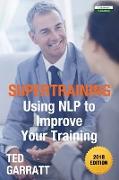- Start
- SuperTraining
SuperTraining
Angebote / Angebote:
Neuro-Linguistic Programming - commonly known as NLP - is a method of communication and engagement used widely in the world of business, sport, and personal-development training.In SuperTraining, join one of the UK's leading trainers - Ted Garratt - as he covers more than 60 NLP techniques and approaches, including: Anchors, Reframing, Creating Rapport, Sleight of Mouth, Non-Verbal Communication, Future Pacing, Matching, and more. This book will help trainers to engage with, and develop, their participants better than ever before.Designed to be a dip-in practical resource, rather than read cover to cover, this book will aid trainers and readers who have a rudimentary understanding of NLP, but it will also benefit complete novices who want to learn about NLP and how it can help them, instructions for implementing the various techniques, alongside case studies and key points, are all included.This is a revisited edition of the original book - The Effective Delivery of Training Using N.L.P.: A Handbook of Tools, Techniques and Practical Exercises.Table of ContentsSection 1. Creating the right environment * Styles of training | Creating rapport | Creating and maintaining high expectations | Creating rituals and engaging emotions | Using exercise bursts to create energy | Acknowledging different learner stylesSection 2. Creating an effective personal state * Maintaining a positive personal state | Creating personal flexibility | Being a learning trainer | Behaviour modelling and strategies | Setting own personal outcomes | Using anchors | Using perceptual positions | Using a variety of training techniques | Using context as well as content clues | Using the big picture/little picture technique | Understanding brain hemisphere functions | Using calibration | Using congruence | Using association/disassociation Section 3. Getting the message across * Using language patterns | Using metaphors | Using reframing | Using backtracking | Using sleight of mouth | Using quotes | Using embedded commands | Using relevancy challenges | Gathering information | Communicating clearly and effectively | Using pre-suppositions | Using effective questions | Using eye accessing cues |Section 4. Being flexible to meet the needs * Getting participants to set own goals | Pacing and leading a group | Using non-verbal communication | Creating group dynamics | Changing learner states | Using humour | Switching roles and styles | Being aware of invisibles (values, beliefs, identity) | Creating reference experiences | Creating new learning patterns | Noticing behavioural changes | Using effective feedback | Unsticking people | Using reverse tests | Maintaining involvement | Instructing people | Creating positive beliefs | Accelerated learning | Using timelines | Using future pacing | Using meta programs | Tasking people | Using chunking | Using sub-modalities | Using memory techniques | Using present state - desired state | Using edits | Using the new behaviour generator | Using internal dialogueSection 5. Confirming the learning * Revising objectives | Agreeing action plans | Using checklists | Effective endings | Post-course self-evaluation | Learning for next timeGlossary of terms
Folgt in ca. 10 Arbeitstagen




